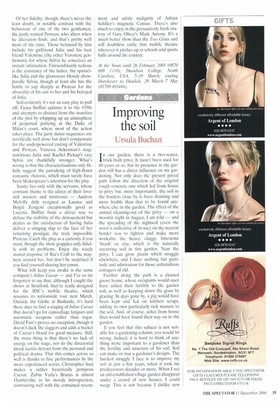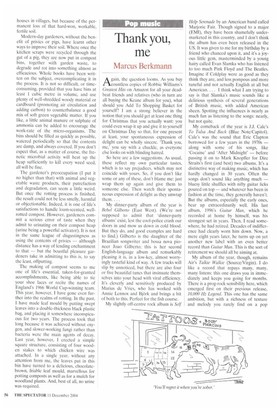Gardens
Improving the soil
Ursula Buchan
In our garden, there is a two-seater, brick-built privy. It hasn't been used for 40 years or so, but its presence in the garden still has a direct influence on my gardening. Not only does the present paved path follow the direction of the original rough concrete one which led from house to privy but, more importantly, the soil in the borders close by is freer draining and more friable than that to be found anywhere else in the garden. The effect of the annual cleaning-out of the privy — on a moonlit night in August, I am told — and the spreading of the nightsoil (even the word is indicative of its use) on the nearest border was to lighten and make more workable the heavy, claggy, limestone 'brash' or clay, which is the naturally occurring soil in this garden. Near the privy, I can grow plants which struggle elsewhere, and I have nothing but gratitude and admiration for those unfastidious cottagers of old.
Further along the path is a disused goose house, whose occupants would once have added their fertility to the garden soil, as well as keeping down the grass by grazing. In days gone by, a pig would have been kept and fed on kitchen scraps, adding its own particularly rich manure to the soil. And, of course, ashes from house fires would have found their way on to the garden.
If you feel that this subject is not suitable for a gardening column, you would be wrong. Indeed, it is hard to think of anything more important to a gardener than the fertility and structure of his soil. Soil can make or mar a gardener's designs. The hardest struggle I face is to improve my soil in just a few years, when it took my predecessors decades or more. When I see an old-established village garden disappear under a crowd of new houses, I could weep. This is not because I dislike new
houses in villages, but because of the permanent loss of that hard-won, workable, fertile soil.
Modern-day gardeners, without the benefit of privies or pigs, have learnt other ways to improve their soil. Where once the kitchen scraps were recycled through the gut of a pig, they are now put in compost bins, together with garden waste, to degrade and rot into something almost as efficacious. Whole books have been written on the subject, overcomplicating it in the process. It is not so difficult, or timeconsuming. provided that you have bins at least 1 cubic metre in volume, and use plenty of well-shredded woody material or cardboard (promoting air circulation and adding carbon) to counterbalance a good mix of soft green vegetable matter. If you like, a little animal manure or sulphate of ammonia can be added to encourage the work-rate of the micro-organisms. The bins should be filled as quickly as possible, watered periodically so that the contents are damp, and always covered. If you don't expect that, as a matter of course, the frenetic microbial activity will heat up the heap sufficiently to kill every weed seed, all will be fine.
The gardener's preoccupation (I put it no higher than that) with animal and vegetable waste products, their putrefaction and degradation, can seem a little weird. But once the rotting process is finished, the result could not be less smelly, harmful or objectionable. Indeed, it is one of life's satisfactions to handle loam-scented, wellrotted compost. However, gardeners commit a serious error of taste when they admit to urinating on their compost heap (urine being a powerful activator). It is not in the same league of disgustingness as using the contents of privies — although distance has a way of lending enchantment to that — but the boastful pleasure gardeners take in admitting to this is, to say the least, offputting.
The making of compost seems to me one of life's essential, taken-for-granted accomplishments, like being able to tie your shoe laces or recite the names of England's 1966 World Cup-winning team. This year, however, I have gone even further into the realms of rotting. In the past, I have made leaf mould by putting swept leaves into a double-thickness black plastic bag, and placing it somewhere inconspicuous for two years. The process took that long because it was achieved without oxygen, and slower-working fungi rather than bacteria were the main agents of decay. Last year, however, I erected a simple square structure, consisting of four wooden stakes to which chicken wire was attached. In a single year, without any attention from me, the leaves put in this bin have turned to a delicious, chocolatebrown, friable leaf mould, marvellous for potting composts as well as for a mulch for woodland plants. And, best of all, no urine was required.











































































 Previous page
Previous page